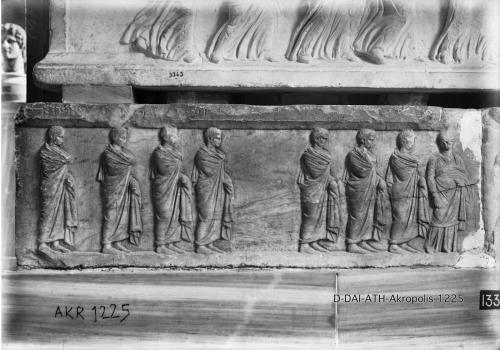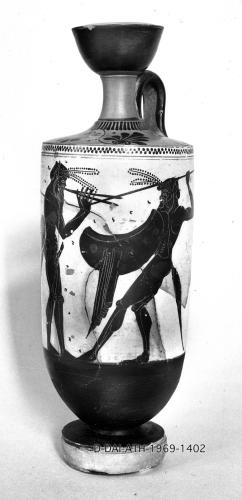One of the most fascinating (and celebrated) inscribed monument in the Arachne collection is the base of a votive offering from the Acropolis of Athens.
- no response to http://www.europeana.eu/api/v2/record/2058811/DAI__6d36213ae227e329b6ea550adc206d96__artifact__cho.json?wskey=ydRg6Ujho&profile=standard!
#0 /var/www/html/eagle/wp-content/plugins/eagle-storytelling/esa_datasource.class.php(222): esa_datasource\abstract_datasource->_fetch_external_data('http://www.euro...') #1 /var/www/html/eagle/wp-content/plugins/eagle-storytelling/esa_datasource.class.php(207): esa_datasource\abstract_datasource->_generic_api_call('http://www.euro...') #2 /var/www/html/eagle/wp-content/plugins/eagle-storytelling/esa_item.class.php(142): esa_datasource\abstract_datasource->get('/2058811/DAI__6...') #3 /var/www/html/eagle/wp-content/plugins/eagle-storytelling/esa_item.class.php(63): esa_item->_generator() #4 /var/www/html/eagle/wp-content/plugins/eagle-storytelling/eagle-storytelling.php(703): esa_item->html(true) #5 /var/www/html/eagle/wp-includes/shortcodes.php(433): esa_shortcode(Array, '', 'esa') #6 [internal function]: do_shortcode_tag(Array) #7 /var/www/html/eagle/wp-includes/shortcodes.php(273): preg_replace_callback('/\\[(\\[?)(captio...', 'do_shortcode_ta...', 'One of the m...') #8 /var/www/html/eagle/wp-includes/class-wp-hook.php(324): do_shortcode('
One of the m...') #9 /var/www/html/eagle/wp-includes/plugin.php(205): WP_Hook->apply_filters('
One of the m...', Array) #10 /var/www/html/eagle/wp-includes/post-template.php(256): apply_filters('the_content', 'One of the most...') #11 /var/www/html/eagle/wp-content/plugins/eagle-storytelling-bridge/template/loop-single-story.php(38): the_content() #12 /var/www/html/eagle/wp-content/plugins/eagle-storytelling-bridge/template/single-story.php(9): include('/var/www/html/e...') #13 /var/www/html/eagle/wp-includes/template-loader.php(106): include('/var/www/html/e...') #14 /var/www/html/eagle/wp-blog-header.php(19): require_once('/var/www/html/e...') #15 /var/www/html/eagle/index.php(17): require('/var/www/html/e...') #16 {main}
In 1852 a basis of a group of bronze statues was discovered on the west end of the Acropolis in Athens, incorporated in the so called Beulé Gate.
2471 - Athens - Acropolis - Beulé Gate - Photo by Giovanni Dall'Orto, Nov 09 2009
- Created at: 2011-09-19 23:50:43
- Description: The Beulé Gate at the Acropolis of Athens, built in the 3rd century AD reusing previusly used cut stones. Picture by Giovanni Dall'Orto, November 9 2009.
- Artist: Giovanni Dall'Orto.
The basis consists of two blocks that were once clamped together. The bronze group that stood on top of it has disappeared but on the upper side of the basis it is still possible to view the traces of the footprints of the statues, both on the left block (two holes), and on the right (four footprints).
The fine relief that decorates the basis can still be appreciated in full. The two parts that make the basis portray a series of 17 figures moving from left to right, who are clearly separated and arranged in different groups. These figures, together with the inscriptions that were carved on each of the blocks, tell a fascinating story about the Athenian society.
On the left block, seven men, fully clad in mantles (hymatia), are advancing towards the right. Between the first and the last four figures there is a space that is well visible on the image above.
On the right border, right before the end of the left block, a woman is standing facing the advancing men. This mysterious female character was previously wrongly identified with a (male) chorus leader.
The right block shows a somewhat specular arrangement: close to the division, a female figure stands facing the viewer, with her gaze turned toward two groups of four young men. These youths are also moving to the right, but their movement is more accentuated, while they advance on the tips of their toes. They are also not clad, but naked, and wear only a helmet on their head and the round hoplitic shield on their outstretched left arms; the fist on their right arms are clenched.
On the upper fascia of the right block a dedication is preserved fairly well; the text, as edited in IG II2 3025, reads:
The text as reported can be translated as: “having won with [pyrrich]istai, Atarbos son of Ly[s… dedicated. C]ephiso[d]oro[s was the archon].”
Short as it is, this inscriptions is very informative and helpful to attempt a reconstruction of this monument’s context. First of all, the name of the author of the offer (Atarbos) is preserved in full. Since the name is not very frequent in Attica, attempts can be made to identify this figure with some precision. Most likely, he must be identified with a man from the demos of Thorikos, and it is very likely that the indication of his provenance (“from Thorikos”) was following the patronymic in the gap. Only two letters (“Ly”) of the name of Atarbos’ father are preserved, and all reconstruction is hypothetical.
- no response to http://gazetteer.dainst.org/search.json?q={%22bool%22:{%22must%22:%5B%20{%20%22match%22:%20{%20%22_id%22:%202308234%20}}%5D}}&type=extended!
#0 /var/www/html/eagle/wp-content/plugins/eagle-storytelling/esa_datasource.class.php(222): esa_datasource\abstract_datasource->_fetch_external_data('http://gazettee...') #1 /var/www/html/eagle/wp-content/plugins/eagle-storytelling/esa_datasource.class.php(207): esa_datasource\abstract_datasource->_generic_api_call('http://gazettee...') #2 /var/www/html/eagle/wp-content/plugins/eagle-storytelling/esa_item.class.php(142): esa_datasource\abstract_datasource->get('2308234') #3 /var/www/html/eagle/wp-content/plugins/eagle-storytelling/esa_item.class.php(63): esa_item->_generator() #4 /var/www/html/eagle/wp-content/plugins/eagle-storytelling/eagle-storytelling.php(703): esa_item->html(true) #5 /var/www/html/eagle/wp-includes/shortcodes.php(433): esa_shortcode(Array, '', 'esa') #6 [internal function]: do_shortcode_tag(Array) #7 /var/www/html/eagle/wp-includes/shortcodes.php(273): preg_replace_callback('/\\[(\\[?)(captio...', 'do_shortcode_ta...', 'One of the m...') #8 /var/www/html/eagle/wp-includes/class-wp-hook.php(324): do_shortcode('
One of the m...') #9 /var/www/html/eagle/wp-includes/plugin.php(205): WP_Hook->apply_filters('
One of the m...', Array) #10 /var/www/html/eagle/wp-includes/post-template.php(256): apply_filters('the_content', 'One of the most...') #11 /var/www/html/eagle/wp-content/plugins/eagle-storytelling-bridge/template/loop-single-story.php(38): the_content() #12 /var/www/html/eagle/wp-content/plugins/eagle-storytelling-bridge/template/single-story.php(9): include('/var/www/html/e...') #13 /var/www/html/eagle/wp-includes/template-loader.php(106): include('/var/www/html/e...') #14 /var/www/html/eagle/wp-blog-header.php(19): require_once('/var/www/html/e...') #15 /var/www/html/eagle/index.php(17): require('/var/www/html/e...') #16 {main}
Another important indication that is preserved in the inscription is the mention of the archon eponymos, the annual magistrate that in Athens gave the name to the year he was in charge for. This information is decisive to date the monument. Actually, two Cephisodoros’s are known in the list of Athenian archontes, and therefore two dates are possible: either 366-5 or 323-2 BCE. While the former is the date indicated in Arachne, the latter is generally preferred today, since a dating to the last quarter of the IV century would be more in agreement with some stylistic details of the relief.
This part of the inscription on the basis, then, commemorates a victory that Atarbos obtained (most likely) in the year 323-2 BCE. But what kind of victory was this monument celebrating? Although the term pyrrichistai is partially lost, its reconstruction does not pose any problem. Indeed, the inscription confirms the identifications of the eight young dancers in the right block, which could be already guessed from their representation. They are dancers of the pyrriche, the most important and best documented weapon dance in Ancient Greece.
Pyrrhichios
The Pyrrhichios dance (“Pyrrhic dance”; Ancient Greek: πυρρίχιος or πυρρίχη, but often misspelled as πυρρίχειος or πυρήχειος) was the best known war dance of the Greeks. It was probably of Doric origin and practiced at first solely as a training for war. Plato (leges, p. 815) describes it as imitating by quick movements the ways in which blows and darts are to be avoided and also the modes in which an enemy is to be attacked. It was dance to the sound of the aulos; it’s time was quick and light, as is also shewn by the metric foot called pyrrhic.
It was described by Xenophon in his work the Anabasis. In that work he writes that at a festival was held in Trapezus to celebrate the arrival of his troops in the city. The following is the part in which the pyrrhic dance is mentioned:
“A Mysian who saw that they were amazed, retorted by persuading one of the Arcadians who had acquired a dancing girl to dress her in the finest costume he could, fit her with a light shield and bring her on to give a graceful performance of the “Pyrrhic” dance. Thereupon there was a roar of applause, and the Paphlagonians asked if the Greek women also fought side by side with their men. The Greeks answered that these were the very women who had routed the king from his camp”
Also Homer refers to Pyrrihios and describes how Achilles danced it around the burning funeral of Patroclos. The dance was loved in all of Greece and especially the Spartans considered it a kind of light war training and so they taught the dance to their children while still young.
Legends about the origin of the dance were various and widespread throughout the Greek world, but at least one tradition linked the dance with the figure of the goddess Athena, who first invented it to celebrate her birth (Lucian, Dial. Deorum 13) or her victory over the Titans (Dion. Hal. Ant. Rom. 7,72,7). In Athens, the pyrriche was indeed included in the competitions held at the most important civic festival for Athena, the Panathenaic Games. Competitions of choruses dancing the pyrriche were held at the Panatenaia, as it is mentioned twice by the defender of Lysias’ Oration 21 (21.1 and 21.4). The second passage (quoted from the Perseus Project) reads:
The mention in Lysias’ oration of the “Little (or Lesser) Panathenaea” is very interesting. Since their reform under Peisistratos, dated to year 566-5 BCE, the most important civic festival of the Athenian calendar were the “Greater Panathenaea”, which were held every four years just like the Olympic games. Between two editions of the major festival, minor editions, called “Lesser Panatheaea”, took place with a reduced program. Both little and great Panathenaic festivals included musical and athletic competitions. It is interesting to notice that the defendant of Lysias’ Oration 21, while insisting on the many occasions on which he had performed the civic duty of paying for the expenses of the performances, gives precise attestation to the existence of competitions of pyrrichistai at both the Greater (21.1) and Lesser Panathenaea (passage quoted). An interesting point about Atarbos’ monument is that, while 366 BCE was a Panathenaic year, 322 was not, so that, if the later dating is correct, we must assume that the victory that is celebrated on the inscription was obtained in the Lesser Panathenaea.
Panathenaic Games
-
The Panathenaic Games (Ancient Greek: Παναθήναια) were held every four years in Athens in Ancient Greece from 566 BC to the 3rd century AD. These Games incorporated religious festival, ceremony (including prize-giving), athletic competitions, and cultural events hosted within a stadium.
Read Full Article
Plato gives a vivid description of the dance, writing that “the warlike division…”
Europeana host a beautiful series of images of modern re-enactment of the pyrriche in a 1930 Delphic festival
- no response to http://www.europeana.eu/api/v2/record/2055708/473881.json?wskey=ydRg6Ujho&profile=standard!
#0 /var/www/html/eagle/wp-content/plugins/eagle-storytelling/esa_datasource.class.php(222): esa_datasource\abstract_datasource->_fetch_external_data('http://www.euro...') #1 /var/www/html/eagle/wp-content/plugins/eagle-storytelling/esa_datasource.class.php(207): esa_datasource\abstract_datasource->_generic_api_call('http://www.euro...') #2 /var/www/html/eagle/wp-content/plugins/eagle-storytelling/esa_item.class.php(142): esa_datasource\abstract_datasource->get('/2055708/473881') #3 /var/www/html/eagle/wp-content/plugins/eagle-storytelling/esa_item.class.php(63): esa_item->_generator() #4 /var/www/html/eagle/wp-content/plugins/eagle-storytelling/eagle-storytelling.php(703): esa_item->html(true) #5 /var/www/html/eagle/wp-includes/shortcodes.php(433): esa_shortcode(Array, '', 'esa') #6 [internal function]: do_shortcode_tag(Array) #7 /var/www/html/eagle/wp-includes/shortcodes.php(273): preg_replace_callback('/\\[(\\[?)(captio...', 'do_shortcode_ta...', 'One of the m...') #8 /var/www/html/eagle/wp-includes/class-wp-hook.php(324): do_shortcode('
One of the m...') #9 /var/www/html/eagle/wp-includes/plugin.php(205): WP_Hook->apply_filters('
One of the m...', Array) #10 /var/www/html/eagle/wp-includes/post-template.php(256): apply_filters('the_content', 'One of the most...') #11 /var/www/html/eagle/wp-content/plugins/eagle-storytelling-bridge/template/loop-single-story.php(38): the_content() #12 /var/www/html/eagle/wp-content/plugins/eagle-storytelling-bridge/template/single-story.php(9): include('/var/www/html/e...') #13 /var/www/html/eagle/wp-includes/template-loader.php(106): include('/var/www/html/e...') #14 /var/www/html/eagle/wp-blog-header.php(19): require_once('/var/www/html/e...') #15 /var/www/html/eagle/index.php(17): require('/var/www/html/e...') #16 {main}
The pyrriche is often depicted also on the Athenian vases, like the white-figured lekythos in the image below, where a pyrrichistes dances at the music of an aulos-player.
But who are the men on the left block? Even if the inscription on that side is much more damaged, some clear indication can still be obtained. As printed in the Inscriptiones Graecae (IG II2 2035), the text reads:
which can be translated as: “having won with the cyclic chorus”, i.e. the chorus performing the dithyramb.
Dithyramb
-
The dithyramb (; Ancient Greek: διθύραμβος, dithyrambos) was an ancient Greek hymn sung and danced in honor of Dionysus, the god of wine and fertility; the term was also used as an epithet of the god. Plato, in The Laws, while discussing various kinds of music mentions "the birth of Dionysos, called, I think, the dithyramb." Plato also remarks in the Republic that dithyrambs are the clearest example of poetry in which the poet is the only speaker.
However, in The Apology Socrates went to the dithyrambs with some of their own most elaborate passages, asking their meaning but got a response of, "Will you believe me?" which "showed me in an instant that not by wisdom do poets write poetry, but by a sort of genius and inspiration; they are like diviners or soothsayers who also say many fine things, but do not understand the meaning of them."
Plutarch contrasted the dithyramb's wild and ecstatic character with the paean. According to Aristotle, the dithyramb was the origin of Athenian tragedy. A wildly enthusiastic speech or piece of writing is still occasionally described as dithyrambic.
Read Full Article
In this poorly preserved text only νικήσας and χορῶι can be considered certain. In any case what we read is enough to learn that, once again, the left block too celebrates a victory in a choral competition. The whole monument therefore is dedicated to glorify the success of Atarbos in a competition of choruses that were taking place in the Athenian religious festivals. Two victories, actually! One was obtained by Atarbos’ chorus in the pyrriché, the other, which is remembered in the left block, most likely in the very prestigious dithyramb competition.
Why did Atarbos set up such a lavish and expensive monument (we must not forget that, apart from the rich relief that we still see, the monument included a group of three bronze statues)? And what role did he play?
Much as the defendant in the quoted passage from Lysias, Atarbos belonged to the wealthy class of Athenians that were called to take up the financing of some of the most important activities in the civic life of Athens. This financial “services” from the wealthiest citizen were know in ancient Greece as leitourgiai. The financial support for the choral performances (including for example the performance of the Greek tragedies during the festivals for Dionysus) were also covered by a liturgy called choregeia. Being choregos was both a financial burden and a great honor for the chosen citizen. The sponsor of a winning chorus drew great prestige from the success and in Atarbos’ times he was expected to display his prize and the memory of his triumph publicly in the streets of Athens. The monument built by a choregos named Lysicrates to commemorate the victory of his chorus to a dramatic festival is particularly famous and well preserved.
Athen, Lysikrates-Denkmal
- Type: Image, Image, Image
- Country: Austria
- Contributor: DiFaB - Photographer, DiFaB - Technical Translator, DiFaB - Photographer, DiFaB - Technical Translator, Choregos Lysikrates - Client/Donor, Konstantin Athanasiou - Photographer
- Date: #2013-01-06, 2013-01-06T09:27:21.000Z
- Format: image/tiff, image/tiff
- Description: Rundbau mit Relieffreis über dem Architrav: Dionysos-Abenteuer mit den Piraten, die er in Delphine verwandelt korinthische Kapitelle
- Identifier: [1]
- Language: xxx
- Subject: Getty Thesaurus of Geographic Names, World, Europe, Europa, European, Ellás, Ellas, Ellinikí Dimokratía, Elliniki Dimokratia, Elliniki Dhimokratia, Greece, Hellenic Republic, Grèce, République hellénique, Griechenland, Grecia, Griekenland, Grécia, GRC, GR, ISO300, GR00, Kingdom of Greece, Hellas, Greek, Hellenic, Periféreia Protevoúsis, Greater Athens, Athínai, Athenai, Athinai, Athens, Atenas, Athènes, Athen, Atene, Athenae, Athēnai, Athine, Getty Art & Architecture Thesaurus, Materials Facet, Materials, Matériaux, materials, material, fabric, substances, matériaux, matériau, materials by composition, matériaux selon la composition, inorganic material, rock, rocks, sedimentary rock, sedimentary rocks, rock, sedimentary, rocks, sedimentary, sedimentary stone, roche sédimentaire, roches sédimentaires, sedimentary rock by composition, roches sédimentaires selon la composition, carbonate rock, calcareous rock, carbonate rocks, rock, calcareous, rock, carbonate, rocks, carbonate, limestone, limestones, calcaire, calcaires, limestone by composition, calcaires selon la composition, limestone by composition: aggregate type, calcaires selon la composition -- types d'agrégat, poros, Getty Art & Architecture Thesaurus, Materials Facet, Materials, Matériaux, materials, material, fabric, substances, matériaux, matériau, materials by composition, matériaux selon la composition, inorganic material, rock, rocks, sedimentary rock, sedimentary rocks, rock, sedimentary, rocks, sedimentary, sedimentary stone, roche sédimentaire, roches sédimentaires, sedimentary rock by form, roches sédimentaires selon la forme, rudaceous rock, rudaceous rocks, psephite, rock, rudaceous, rocks, rudaceous, breccia, Getty Art & Architecture Thesaurus, Materials Facet, Materials, Matériaux, materials, material, fabric, substances, matériaux, matériau, materials by composition, matériaux selon la composition, inorganic material, rock, rocks, metamorphic rock, metamorphic rocks, metamorphic stone, rock, metamorphic, rocks, metamorphic, stone, metamorphic, roche métamorphique, roches métamorphiques, roche cristallophyllienne, marble, marbles, marmor, marbre, marbres, marble by color or pattern, marbres selon la couleur ou le motif, white marble, white marbles, marble, saccharoidal, marble, white, saccharoidal marble, marbre blanc, marbres blancs, Hymettian marble, greco rigato, marble, Hymettian, marmor cipolla, marmor Hymmetium, marmor imezio, onion marble, Getty Art & Architecture Thesaurus, Materials Facet, Materials, Matériaux, materials, material, fabric, substances, matériaux, matériau, materials by composition, matériaux selon la composition, inorganic material, rock, rocks, metamorphic rock, metamorphic rocks, metamorphic stone, rock, metamorphic, rocks, metamorphic, stone, metamorphic, roche métamorphique, roches métamorphiques, roche cristallophyllienne, marble, marbles, marmor, marbre, marbres, marble by color or pattern, marbres selon la couleur ou le motif, white marble, white marbles, marble, saccharoidal, marble, white, saccharoidal marble, marbre blanc, marbres blancs, Pentelic marble, cipolla, greco fino, marble, Pentelic, marmor Pentelicum, Pentelico, Pentelikos lithos, Getty Art & Architecture Thesaurus, Objects Facet, Visual and Verbal Communication, Visual Works, Oeuvres Visuelles, visual works, oeuvres visuelles, oeuvre visuelle, visual works by medium or technique, photographs, photograph, photos, photographies, photographie, photographs by form, photographies selon la forme, positives, positive, photographic prints, photographic print, photoprints, print, photographic, prints, prints, photographic, épreuves photographiques, épreuve photographique, photographic prints by process, épreuves photographiques selon le procédé, albumen prints, albumen print, albumen photoprints, albumen prints, silver, albumen silver prints, photoprints, albumen, prints, albumen, prints, albumen silver, prints, silver albumen, silver albumen prints, silver prints, albumen, épreuves à l'albumine, épreuve à l'albumine, Getty Art & Architecture Thesaurus, Objects Facet, Object Genres, Catégories d'objets, object genres, catégories d'objets, architecture
- id: /9200210/o_262557
A recent detailed re-examination put forward a very interesting hypothesis about the genesis and evolution of the monument. According to it, the monument was set up in two stages. In a first phase, it included only the right half and was surmounted by a pillar that commemorated the Panathenaic victory of the pyrrichistai. After the success of the dithyramb chorus, a second block was added, while the stone pillar was removed and replaced by the group of statues. The monument then was rearranged in the unitary composition that (at least partly) we can see and imagine today. One interesting aspect, also noted by Dr. Shear in the quoted paper, is that the two inscriptions (literally: “having won […] with a chorus” and “[with the pyrrich]istai having won”) are disposed in the unified monument according to a chiastic, mirror-like, pattern that is also reflected in the arrangement of the female figures and the choruses, as we noted above.
Most likely, since Cephisodoros remains the only archon mentioned in the inscription, the two victories were obtained in the same year. And we can then speculate about how especially fortunate the year of the archonship of Cephisodoros was for Atarbos and how eager he was to display his gratitude (and his pride) for such prestigious achievements!
Finally, we are left with two unanswered questions.
Who are the female characters that are placed in specular position at the end and the beginning of the group of dancers? Various hypotheses have been made, but archaeologists have not reached a consensus.
And why are the men in the left block disposed in such an articulate arrangement, with two separated groups and one figure isolated on the left?




